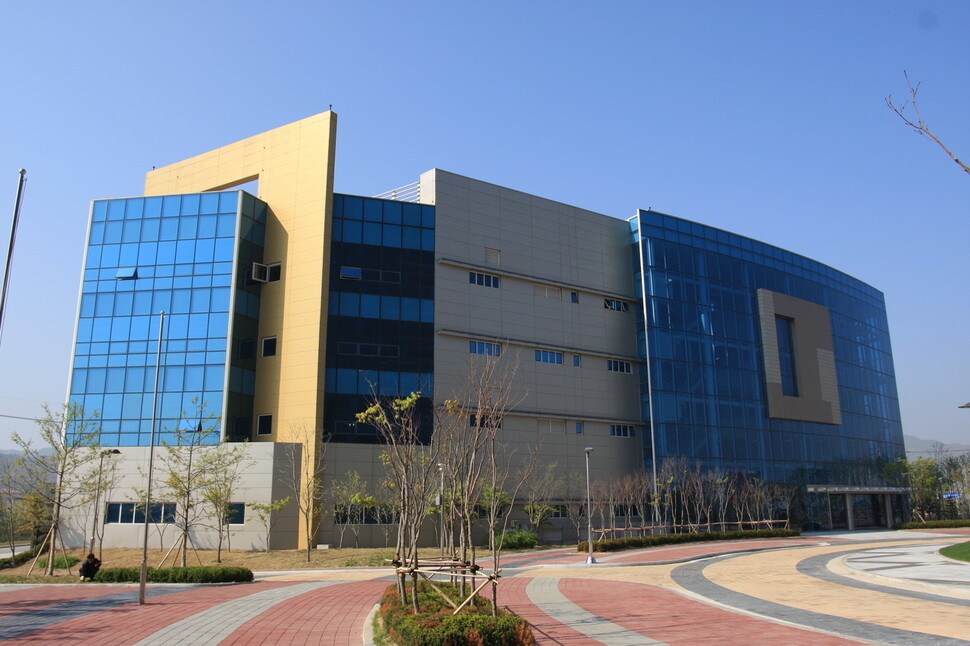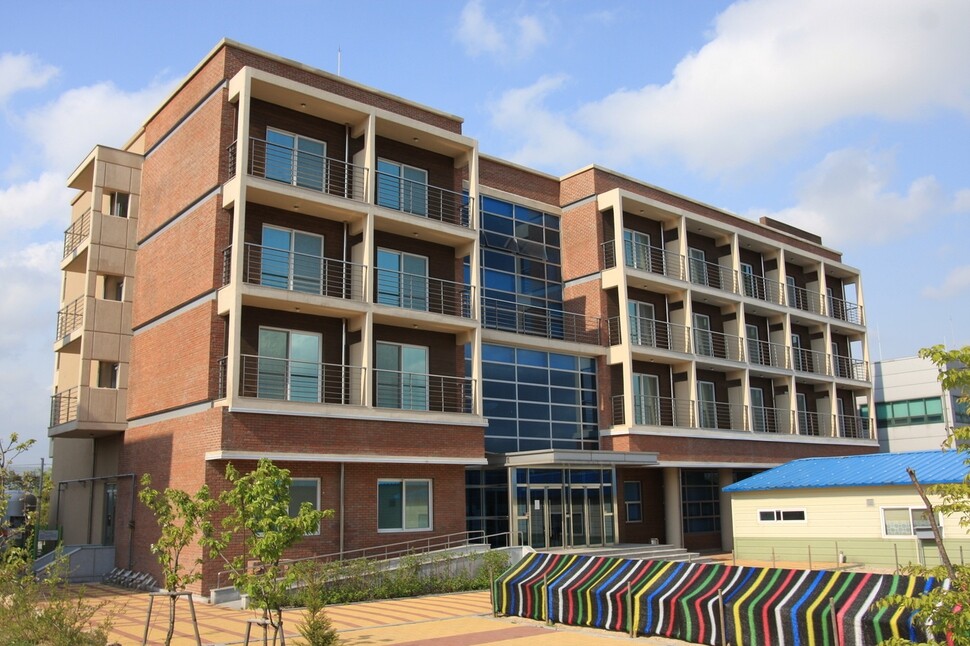hankyoreh
Links to other country sites 다른 나라 사이트 링크
Inter-Korean liaison office to begin operations immediately after opening ceremony on Sept. 14

South Korea’s Unification Ministry has announced that the inter-Korean liaison office specified in the Apr. 27 Panmunjom Declaration will begin operations immediately after South and North Korea hold the opening ceremony on Sept. 14.
The opening of a permanent channel for deliberations between South and North Korean officials in the face of US opposition serves as another stepping stone toward the success of the upcoming inter-Korean summit in Pyongyang. The establishment of a dialogue channel permanently staffed by officials from the two sides is regarded as a first, though rudimentary, step toward an inter-Korean confederation. The liaison office will be initially directed by the vice minister of South Korea’s Unification Ministry and the vice chair of North Korea’s Committee for the Peaceful Reunification of the Fatherland.
“We’ve agreed to hold the opening ceremony in front of the main entrance to the inter-Korean liaison office building at 10:30 am on Sept. 14. The liaison office will be housed in the building of the old inter-Korean exchange and cooperation consultation office, inside the Kaesong Industrial Complex, which has already been repaired and refurbished,” the Unification Ministry said on Sept. 12.
“We agreed that the liaison office directors will hold the rank of vice minister, and North Korea has officially notified us that the position will be held by the vice chair of the Committee for the Peaceful Reunification of the Fatherland. We’re planning to appoint Vice Minister of Unification [Chun Hae-sung] as director,” Unification Ministry Spokesperson Baik Tae-hyun said during the regular press briefing on Wednesday.

Vice minister level director to be permanent representative for negotiations
“The director will take on the role of ‘permanent representative for negotiations,’ presiding over a regular weekly meeting and deliberations when necessary and discussing and resolving urgent issues facing South and North Korea,” Baik added.
The Unification Ministry announced that the liaison office director “will serve both as the responsible liaison officer and as the representative for negotiations and deliberations with North Korea and when necessary will directly convey messages between top officials from the two sides.”
During the opening ceremony, South Korea will be represented by between 50 and 60 officials from the National Assembly, the government, academia and civic groups, including Unification Minister Cho Myung-gyon. A similar number of North Koreans will be in attendance, including negotiators for various categories of talks and Ri Son-gwon, chairman of the Committee for the Peaceful Reunification of the Fatherland Chairman.
“The liaison office will carry out the following functions: working on negotiations and communication, working on talks and deliberations between officials, supporting private-sector exchange and ensuring the convenience of staff traveling across the border,” the Unification Ministry said.
According to the Unification Ministry’s organizational plan for the newly established inter-Korean joint liaison office, which was passed in a cabinet meeting on Sept. 11, the South Korean half of the liaison office will possess the following hierarchical structure: a director, a secretary-general and three department heads.
Kim Chang-su, currently policy advisor to the Unification Minister, will be reassigned as secretary-general (which means elevation to the Senior Civil Service). In this role, Kim will handle daily affairs at the Kaesong office while working there full-time on behalf of Chun, the actual director, who is effectively working part-time. The secretary-general will be overseeing the three departments, namely operations, exchange, and contact and cooperation.
Communication 24 hours a day, 365 days a year the beginning of Korean confederation
The new liaison office will be combining the roles of the current Panmunjom liaison office and the Kaesong inter-Korean exchange and cooperation consultation office, along with additional functions. “It will be supervising all aspects [of inter-Korean relations],” Baik said. In regard to the vision of turning the liaison office into a permanent mission, which has been repeatedly stressed by South Korean President Moon Jae-in, Paik said, “We think that a basic consensus has formed between South and North Korea.”
South and North Korea agreed to staff at least 15 people in their respective halves of the office, and the South Korean office will have 30 full-time workers, including the secretary-general and 30 officials from the Unification Ministry, the Ministry of Land, Infrastructure and Transport (or the Ministry of Economy and Finance); the Ministry of Culture, Sports and Tourism; the Ministry of the Interior and Safety; and the Korea Forest Service.
The official working hours at the liaison office will be 9 am to 5 pm Monday through Friday, but there will also be officials on overnight and weekend duty, which means that the office will effectively be running 24 hours a day.
“The operations of the liaison office are still at a rudimentary level, but it’s the beginning of a transition to an inter-Korean confederation,” said Kim Yeon-cheol, director of the Institute of National Unification.
“This creates a hub for mediating exchange and cooperation in each area, not only for government officials but also for the private sector and local government. This paves the way for orderly deliberations about exchange and cooperation and makes it possible to avoid wasting time and money traveling to China and other countries.”
“The liaison office will establish itself as a permanent channel of deliberations and communications aimed at developing inter-Korean relations, easing military tensions and establishing peace. Having communication 24 hours a day, 365 days a year is expected to keep inter-Korean relations stable and also help North Korea and the US’s deliberations about denuclearization,” the Unification Ministry said.
By Lee Je-hun, senior staff writer
Please direct comments or questions to [english@hani.co.kr]

Editorial・opinion
![[Column] Season 2 of special prosecutor probe may be coming to Korea soon [Column] Season 2 of special prosecutor probe may be coming to Korea soon](https://flexible.img.hani.co.kr/flexible/normal/500/300/imgdb/original/2024/0426/3317141030699447.jpg) [Column] Season 2 of special prosecutor probe may be coming to Korea soon
[Column] Season 2 of special prosecutor probe may be coming to Korea soon![[Column] Park Geun-hye déjà vu in Yoon Suk-yeol [Column] Park Geun-hye déjà vu in Yoon Suk-yeol](https://flexible.img.hani.co.kr/flexible/normal/500/300/imgdb/original/2024/0424/651713945113788.jpg) [Column] Park Geun-hye déjà vu in Yoon Suk-yeol
[Column] Park Geun-hye déjà vu in Yoon Suk-yeol- [Editorial] New weight of N. Korea’s nuclear threats makes dialogue all the more urgent
- [Guest essay] The real reason Korea’s new right wants to dub Rhee a founding father
- [Column] ‘Choson’: Is it time we start referring to N. Korea in its own terms?
- [Editorial] Japan’s rewriting of history with Korea has gone too far
- [Column] The president’s questionable capacity for dialogue
- [Column] Are chaebol firms just pizza pies for families to divvy up as they please?
- [Column] Has Korea, too, crossed the Rubicon on China?
- [Correspondent’s column] In Japan’s alliance with US, echoes of its past alliances with UK
Most viewed articles
- 1‘We must say no’: Seoul defense chief on Korean, USFK involvement in hypothetical Taiwan crisis
- 2[Column] Season 2 of special prosecutor probe may be coming to Korea soon
- 3N. Korean delegation’s trip to Iran shows how Pyongyang is leveraging ties with Moscow
- 4Korea sees more deaths than births for 52nd consecutive month in February
- 5Amnesty notes ‘erosion’ of freedom of expression in Korea in annual human rights report
- 6[Reportage] On US campuses, student risk arrest as they call for divestment from Israel
- 7[Editorial] New weight of N. Korea’s nuclear threats makes dialogue all the more urgent
- 8‘Weddingflation’ breaks the bank for Korean couples-to-be
- 9[Column] Has Korea, too, crossed the Rubicon on China?
- 10[Column] Park Geun-hye déjà vu in Yoon Suk-yeol